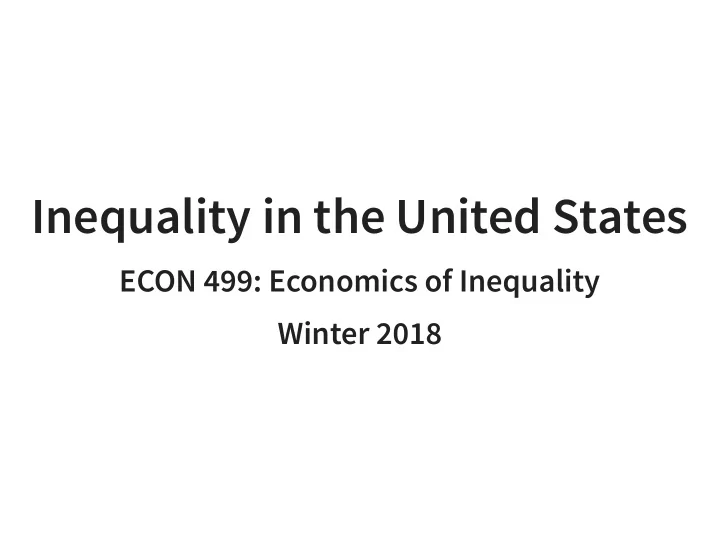

Inequality in the United States ECON 499: Economics of Inequality Winter 2018
What is inequality? We know how to think about inequality theoretically How do we measure inequality? What can the data tell us?
Kuznets hypothesis Poor countries have homogeneous labor, mostly agriculture As countries develop, cities become industrial centers Creates urban/rural wage gap, increasing inequality As development increases, rural workers become educated and move to cities Reduces supply of rural workers, increases wages, decreases inequality
Kuznets curve
Piketty and Saez, 2003 "Income inequality in the United States, 1913-1998" One of the first papers to estimate long-run evolution of inequality Two of the most prominent empirical researchers Renewed economists interest in inequality Much of these findings are included in Piketty's famous book (which we will talk about later)
Data Tax return statistics reported by IRS Most people did not pay income tax prior to 1944, so focus on top 10% Gross income: Wages, profits, dividends, interest, rents, etc Exclude capital gains (people don't sell assets every year, therefore it is "lumpy") Calculated before any taxes, deductions, or transfers
The fall in top income share 1938-1939 World War II funded primarily through corporate income tax Top incomes were mostly earned through capital income
Declining capital incomes Capital incomes for the top income earners have declined steadily since WWII Capital income is derived from wealth A � er WWII ended, why did capital incomes not recover to previous levels? Why are the wealthy not earning as much capital income today?
Progressive taxation: A possible explanation Pre WWI taxes are relatively flat, allowed wealth to accumulate Great depression and WWII "shocks" decreased the wealth of the top earners Progressive taxation and corporate taxes prevented wealth from accumulating to previous levels
The rise in top income a � er 1970 Primarily labor income Tax Reform Act of 1986: Top marginal tax rate changed from 50% to 28% Raised to 39.6% by 1993 Initial cut coincides with rapid growth of top incomes
A mystery? It's not clear from the data what is causing the rapid rise in top incomes Piketty and Saez speculate that changing social attitudes toward executive pay may be a factor
Critiques of Piketty and Saez Only looking at income in the top 10%, ignoring inequality elsewhere in the distribution ("transfer sensitivity" principle) The unit of observation is the "tax unit", not weighting observations by number of people, children, etc Their definition of income ignores non-market sources
What is income? Piketty and Saez: Salaries and wages Capital gains Other sources: Benefits Taxes "In kind" transfers
Market vs comprehensive income Market income: The pre-tax compensation earned in exchange for selling labor Income from capital: profits, interest, etc Comprehensive income: Market income plus "everything else" The total money received that can be used to purchase goods and services
Healthcare A large non-market source of income People need to consume health services whether or not they have insurance Employer-provided insurance isn't included in wages, by allows people to consume more than they otherwise could Kaestner and Lubotsky (2016), optional on Canvas
Healthcare facts Healthcare expenses were 17% of GDP in 2014 70% of expenses paid by public or private insurance (not out-of-pocket) 36% of all expenses paid by Federal programs Medicaid and Medicare Average Medicaid recipient receives \$9,125 per year (family of 3)
Medicare Covers nearly all citizens age 65 and older Covers some disabled citizens under 65 Financed by 2.9% payroll tax (+0.9% for high income earners) Average beneficiary receives \$11,400 Adults over 65 generally have lower income than those under 65 Transfer from relatively high incomes to lower incomes Reduces inequality (principle of transfers)
Medicaid Provides insurance for low income families Covers 60 million people Reduces inequality
A ff ordable Care Act Allows states to expand Medicaid coverage (many don't) O ff ers subsidies to people with less than 400% federal poverty level Increased the coverage for low-income workers Reduces inequality
Employer provided healthcare Most middle and high-income earners receive insurance through their employer Employee contributions untaxed – increases income of middle and top earners Increases inequality
Recommend
More recommend